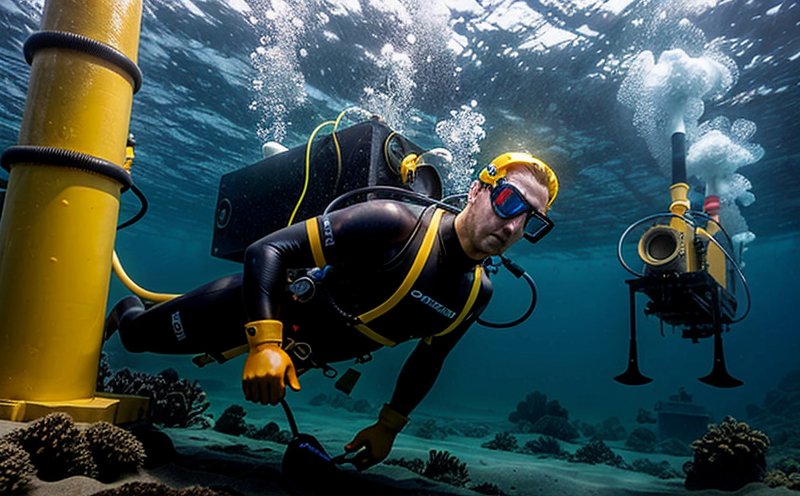DNVGL-OS-C401 Subsea Structural Welding Testing
The DNVGL-OS-C401 standard is a pivotal guideline for ensuring the reliability, safety, and integrity of subsea structural welding. This testing protocol is critical in marine environments where structural components must withstand harsh conditions over extended periods. The scope encompasses various types of welds used in subsea structures such as pipelines, platforms, and production facilities.
The standard stipulates specific requirements for pre-welding assessments, welding procedures, inspection methods during the process, and post-weld evaluation checks to guarantee that the welded joints meet predefined quality levels. These stringent requirements are aimed at preventing potential failures in subsea structures which could lead to accidents with severe environmental and economic consequences.
The testing typically involves a series of steps: initial qualification tests on welding procedures, non-destructive inspection methods like radiography or ultrasonics during the welding process, and finally comprehensive evaluation checks such as hardness testing, chemical composition analysis, and mechanical property assessments. The ultimate objective is to ensure that each weld meets the stringent quality criteria set forth by DNVGL-OS-C401.
For compliance with this standard, meticulous planning and execution are essential. This includes selecting appropriate welding equipment and consumables, ensuring operator qualifications, and adhering strictly to prescribed procedures throughout the entire process. Proper documentation is also crucial; all steps from initial setup through final inspection should be recorded accurately for traceability.
Given the critical nature of subsea structures in offshore operations, compliance with DNVGL-OS-C401 is not just a best practice but often a regulatory requirement. Many industries operating within this sector rely heavily on these standards to maintain high safety standards and avoid costly disruptions or accidents due to structural failures.
The importance of this testing cannot be overstated; it underscores the need for rigorous quality control measures in subsea welding processes. By adhering strictly to DNVGL-OS-C401, organizations can ensure they meet not only international but also local regulatory requirements while enhancing overall safety and operational efficiency.
- Compliance with this standard ensures that all welded joints are thoroughly inspected and evaluated according to internationally recognized criteria.
- It helps maintain the highest levels of safety by preventing potential failures in subsea structures.
- The process guarantees adherence to stringent quality standards, which is vital for long-term reliability.
In summary, DNVGL-OS-C401 Subsea Structural Welding Testing plays a crucial role in safeguarding the integrity and safety of subsea structures. By adhering to these rigorous testing procedures, organizations can ensure not only compliance with international standards but also enhance their reputation for quality and reliability.
Benefits
The implementation of DNVGL-OS-C401 Subsea Structural Welding Testing offers several significant benefits:
- Enhanced Safety: By ensuring that all welds meet the highest safety standards, this testing protocol minimizes risks associated with structural failures in subsea environments.
- Increased Reliability: Rigorous inspection and evaluation processes increase confidence in the long-term performance of subsea structures, reducing maintenance costs and downtime.
- Regulatory Compliance: Adhering to this standard helps organizations meet both international and local regulatory requirements, thus avoiding potential legal issues or penalties.
- Improved Reputation: Demonstrating commitment to quality through strict adherence to recognized standards enhances an organization's reputation within the industry.
In addition to these tangible benefits, implementing DNVGL-OS-C401 also fosters a culture of continuous improvement and excellence in subsea welding practices. This approach ensures that all stakeholders, from manufacturers to end-users, benefit from safer, more reliable products and services.
International Acceptance and Recognition
The DNVGL-OS-C401 standard is widely accepted and recognized across the global maritime industry. Its broad acceptance is due to its stringent requirements which ensure that subsea structures are built with the utmost safety in mind.
Many leading manufacturers and operators of marine equipment have adopted this standard as a benchmark for quality control in their operations. The standard's rigorous testing procedures provide peace of mind, knowing that every weld meets internationally recognized criteria. This recognition extends beyond individual companies; it contributes to the overall integrity and reliability of the global maritime sector.
The international acceptance of DNVGL-OS-C401 also facilitates seamless integration into various regulatory frameworks around the world. Compliance with this standard ensures compatibility with local regulations, making it easier for organizations to operate across borders without facing additional challenges related to differing standards or requirements.
Moreover, adhering to such a stringent and widely accepted standard enhances an organization's reputation in the industry. It demonstrates a commitment to excellence and quality that is valued by customers, partners, and stakeholders alike. This positive perception can lead to increased business opportunities and partnerships with reputable organizations globally.





